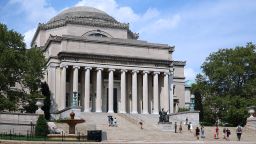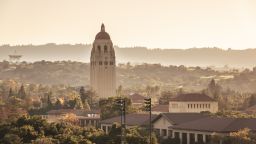Editor’s Note: Michael Thaddeus is a professor of mathematics at Columbia University. The views expressed in the commentary belong to the author. View more opinion at CNN.
The scandal engulfing Columbia University and U.S. News & World Report rose to a new level last week, when Columbia acknowledged that some of the figures it had submitted last year to U.S. News were inaccurate. U.S. News initially removed Columbia from its ranking entirely, then demoted it from second to 18th place after Columbia declined to submit this year’s ranking survey.

The article that first exposed Columbia’s misrepresentation was written not by a disgruntled rival but by a tenured professor in Columbia’s own math department. Many people must have scratched their heads and wondered, “Why did he do it?”
I am the Columbia math professor in question, and I would be the first to admit that what I did was both unusual and unpleasant. I began looking into the matter because my suspicions were piqued by Columbia’s dubious claim to U.S. News that 83% of its undergraduate classes enrolled under 20 students. I assumed that Columbia would address the questions I raised promptly and forthrightly. I never guessed that its response would be so slow and clumsy, causing the scandal to drag on for months. While the short-term damage to Columbia’s reputation has been painful to witness, I’m convinced that it was necessary for me to speak out.
Columbia’s leadership over the last two decades has made an unsustainable choice to portray life at the university in ways that are fundamentally at odds with reality. The phony ranking data are merely symptoms of this deeper malaise.
The public was told for years, for example, that Columbia had a higher proportion of small undergraduate classes (those with fewer than 20 students) than any other leading university. Last week, the truth that Columbia faculty and students have long known was confirmed: our undergraduate class sizes are by no means remarkably small. In fact, Columbia’s proportion of small classes is the second-worst in the Ivy League, not the best as Columbia had claimed.
Likewise, our administration had claimed that the overwhelming majority of faculty on our main campus was full-time, but now we learn that this, too, was false. In reality, the numbers of part-time faculty and full-time faculty are almost the same. Columbia, like so many other universities, is embracing the “gig economy,” outsourcing much of its instruction to temporary workers, who lack both adequate benefits and the protection of tenure that has enabled me to speak freely.
To be sure, Columbia is a wealthy institution with a multi-billion-dollar endowment, but its assets have too often been misspent. Funds have been squandered on misguided projects, like a string of “Global Centers” on four continents, which do not recruit students and do not hire faculty, only administrators.
Meanwhile, the core components of the university, including its undergraduate colleges, are starved for resources and space. There are more than 9 students on the meal plan for every seat in our packed dining halls, according to a report in the Columbia Daily Spectator last spring. Consequently, our students frequently can’t sit down at meal times and have to eat standing up. That’s unworthy of a top-ranked university; in fact, it’s unworthy of any university at all.
Columbia often boasts of its financial commitment to students in Columbia College, who are admitted without regard to their ability to pay, and who are offered debt-free financial aid packages. It is less fond of discussing the terms offered to undergraduates in its School of General Studies, who, even though they tend to come from less wealthy families, receive far less generous financial aid and frequently incur severe debts.
In this context, Provost Mary Boyce’s announcement earlier this month attributing the U.S. News reporting inaccuracies to “outdated and/or incorrect methodologies,” rang hollow to many students and faculty. Something more than methodology is at fault when one of the key figures, reported to be 83%, actually turns out to be 57%. Many pressing questions remain unanswered: How long did the misrepresentations persist? Who was responsible for them? And did our top leadership, including Boyce and President Lee Bollinger, know what was afoot?
These questions can only be satisfactorily addressed by an independent review, conducted by an external body such as a law firm. Columbia should commission one right away, without delays or excuses. This has been standard practice in the all-too-common scandals involving the U.S. News rankings, including one at Claremont McKenna College in 2012 that led to the resignation of its dean of admissions, and another at Temple University in 2018 that led to the imprisonment of the business school dean for conspiracy and wire fraud.
U.S. News, too, has much to answer for in this scandal. While it casts the college rankings as a consumer service, the product it peddles has done enormous harm to American higher education. Its conception of academic merit is simplistic and distorted. U.S. News claims to determine the “Best Colleges,” but all it really does is add up a series of somewhat extraneous variables, such as alumni giving and administrative spending.
It makes no attempt to assess the quality of teaching and scholarship directly. For how could it? A good education is a subtle thing that is far too complex to be reduced to a single number. The one-size-fits-all approach of the U.S. News ranking ignores the reality that different students have different interests and needs. Some favor the arts, for example, while others prefer the sciences, but the ranking makes no such distinction. Students are ill advised to rely on an arbitrary rating assigned by others rather than choosing thoughtfully for themselves.
U.S. News says it relies on schools to report their data accurately. But asking schools to report unaudited data about themselves exposes them to intense conflicts of interest. Administrators are incentivized to manipulate figures, game the system, and focus on parameters of dubious importance while paying scant attention to what happens in the classroom.
At the most basic level, the U.S. News ranking is a failure because the purported facts on which it is based cannot be trusted. Plainly, its vetting of the data reported by colleges has been cursory, even shoddy.
Fortunately, society is waking up to the chicanery of the rankings scam. The US Secretary of Education, Miguel Cardona, called college rankings “a joke” in a speech last month. “Breaking Ranks,” a new book by former Reed College President Colin Diver, sweeps away whatever shreds of credibility the rankings business retains. Meanwhile, websites like College Scorecard and College Navigator, created by the US Department of Education and the National Center for Education Statistics, are providing a meaningful alternative to rankings by supplying fine-grained data and permitting applicants to search based on their interests. There’s hope that future students will see college rankings for what they are: a deception and a distraction.
The details of this scandal, like most scandals, are complicated and confusing. But its lessons are clear and simple. Columbia should conduct a thorough housecleaning of its administrative leadership and renew its commitment to teaching and research. And U.S. News should get out of the rankings business altogether.





